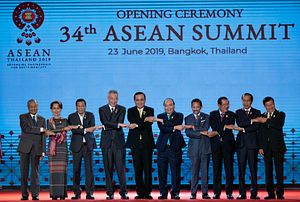Indonesia has often spoken of its vision for an “ASEAN-style Indo-Pacific.” That term is now official, at least according to the ASEAN Outlook on the Indo-Pacific adopted at the 34th ASEAN Summit in late June, which incorporates Indonesia’s vision and indeed goes further.
Keywords for the ASEAN-style Indo-Pacific described in the Outlook are “inclusivity” and “ASEAN centrality.” The first emphasizes that cooperation in the Indo-Pacific should be open to all countries in the region, and also denotes the need to encompass all countries. This emphasis reflects the fact that the Free and Open Indo-Pacific strategy (FOIP), embraced by the United States and Japan, is based on an implicit premise, namely that it is exclusive of China. Amid an escalating U.S.-China confrontation, it is hard to construe Washington’s talk of cooperation in the Indo-Pacific and FOIP as being devoid of any intention to contain China.
In contrast, the Outlook describes the use of ASEAN-led architecture consisting of systems such as EAS, ARF, ASEAN + 3, and ADMM+, which includes major Indo-Pacific countries, including China. The fact that ASEAN countries express Indo-Pacific cooperation using this architecture underscores ASEAN’s aim to present the Indo-Pacific in a form that also includes China, rejecting the notion of exclusiveness.
Repeated references to ASEAN centrality may reflect a concern that ASEAN countries could slide into irrelevance amid a great power confrontation. For this reason, the Outlook emphasizes the use of ASEAN-led regional architecture. In fact, this architecture has been developed by attempting to institutionalize “ASEAN centrality,” and through this architecture the coalition of small and middle powers that is ASEAN has played a certain role in regional politics. Moreover, half of the “Principles” of Indo-Pacific cooperation expressed in the Outlook are the standards and rules that constitute the “ASEAN way,” such as respect for sovereignty, non-intervention, complementarity with existing cooperation frameworks, equality, mutual respect, mutual trust, mutual benefit and respect for international law, such as the UN Charter and the 1982 UN Convention on the Law of the Sea.
The document also suggests that Indo-Pacific cooperation be conducted based on the “ASEAN way.” In other words, the ASEAN-style Indo-Pacific concept maintains a relationship with major powers including the U.S. and China, without joining either one’s camp, in the context of a growing confrontation between the two nations. At the same time, it retains a certain degree of ASEAN influence in maintaining order in the broader region of the Asia-Pacific or Indo-Pacific. Thus, the concept is premised on the avoidance of the worst-case scenario of ASEAN being torn apart by an intensification of the U.S.-China confrontation. It also envisages maintaining a stable ASEAN-led regional system architecture, which would be harnessed to stabilize the relationship between the major powers in the broader Indo-Pacific, while encouraging socioeconomic development and cooperation, bringing stability and prosperity to the region.
I understand what the ASEAN countries aspired to achieve through this concept. In practical terms, though, it is a very difficult task. For example, with regard to efforts to build connectivity infrastructure, one of the specific areas of cooperation, the initial focus is supposed to be on infrastructure development in keeping with the existing Master Plan on ASEAN Connectivity (MPAC 2025), implicitly underlining the need for cooperation in line with ASEAN Centrality. However, developing infrastructure in ASEAN countries naturally relies on the injection of foreign capital and the introduction of foreign technologies, including that from China. In this context, some ASEAN countries have generally expressed approval for the Belt and Road Initiative (BRI), while remaining fully cognizant of the risks. On the other hand, some ASEAN countries have at times shown strong enthusiasm for other cooperation in infrastructure development, including the FOIP advocated by Japan. For instance, the Tokyo Strategy 2018 for Mekong-Japan Cooperation adopted at the 10th Mekong-Japan Summit Meeting held in Tokyo in October 2018 confirmed the importance of the FOIP in developing the Mekong, and declared that both parties would cooperate to achieve this.
Even if there is confrontation between the great powers, then it well may be that the ASEAN countries can benefit from the support of both the U.S. and China and achieve their own centrality. However, at the height of the current tensions, infrastructure development increasingly reflects strategic competition. For example, Japan, the United States, and Australia have announced that they will lend more than $1 billion to finance a liquefied natural gas project in Papua New Guinea. This is clearly designed to counter China’s expanding influence in the South Pacific, supported by BRI aid.
When the logic of competition is introduced into infrastructure development, to what extent can Indo-Pacific cooperation based on inclusivity and ASEAN centrality be achieved?
Of course, it is not as if there is no cause for optimism at all. China, the United States, and Japan can hardly ignore ASEAN if they aim to achieve their individual visions for the international environment. Indeed, in response to criticism that ASEAN is absent from the FOIP set out by Japan in 2018, the Japanese government has revised the trajectory of the FOIP out of particular consideration for the centrality of ASEAN. There is no doubt that ASEAN making its voice heard with its proposal of a unique “Indo-Pacific” is an essential step in the creation of a truly stable regional order.
Mie Oba is a professor at the Tokyo University of Science.

































